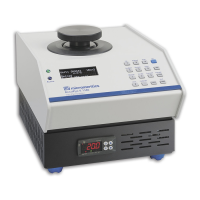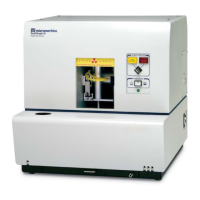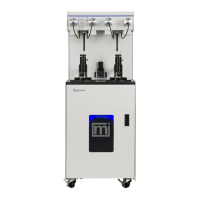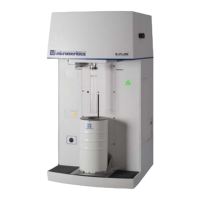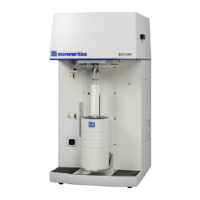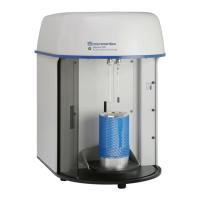C FREE-SPACE CORRECTION
Free space is that volume of the sample tube which is unoccupied by the sample. The quantity of
gas dosed into the sample tube is calculated from the difference in pressures in the manifold
before and after the dose is delivered. The quantity of gas adsorbed by the sample is calculated
by subtracting the quantity of gas remaining in the free space of the sample tube after equilibrium
is established from the quantity of gas originally dosed into the sample tube. Free space must be
determined accurately to obtain a precise value for quantity adsorbed.
Static-volumetric systems consist basically of a gas manifold joined to a sample tube by an
isolation valve. The manifold section has connections for an absolute pressure transducer, a
temperature gauge, and a vacuum system. It also has inlets for the adsorptive gas and helium. A
Dewar flask containing a cryogenic liquid (usually LN
2
at approximately 77 K) is situated so that it
can be raised to immerse most of the sample tube. Two temperature zones exist within the
sample tube when immersed in the cryogenic bath: a warm zone (the volume above the liquid
level and near ambient temperature) and a cold zone (the volume below the liquid level at
cryogenic temperature). Not only must the total free space volume be determined, but it also is
necessary to determine the quantity of gas residing within the “cold” zone since a nonideality
correction must be applied to only that quantity of gas.
The total quantity of gas in the partly immersed sample holder cannot simply be determined using
n=PV/RT because temperature is not constant over the total volume, but instead is distributed as
two temperature zones with a steep temperature gradient between them. A convenient method for
resolving this problem is to derive two factors which, for the existing temperature profile, can be
multiplied by the prevailing pressure to reveal the molar volume of gas contained in the cold zone
and the total quantity residing in the free volume of the immersed sample holder (the analysis free
space).
The analyzer provides the following methods for free space determination:
n
Measure
n
Calculate
n
Enter
MEASURE
Generally, this method, although requiring a little more time (approximately 10 minutes), is the
most preferred one for determining free space. It is simple, automatic, requires very little
information, and essentially is error-proof. With this method, the instrument first evacuates the
manifold and sample tube (containing sample), then isolates the sample tube by closing the valve.
Then the manifold is charged with helium, the pressure measured, and the valve opened allowing
the helium to expand into the sample tube at ambient temperature. Again the pressure is
measured.
C Free-Space Correction
TriStar II Plus Operator Manual
303-42800-01 (Rev M ) — Sep 2023
C - 1
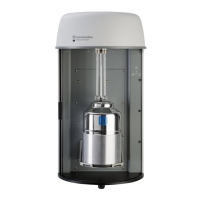
